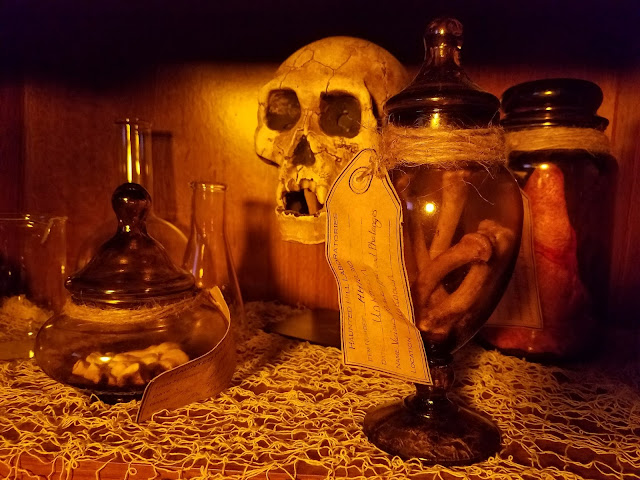$35 - $40 (based on 2015 prices)
Makes three talismans
These quickly became my favorite build for 2015’s haunt and the props which garnered the most reactions (both disgust and praise). I originally intended to use grapevine stars to fashion Blair-Witch-like figures for the voodoo alters. Creativity quickly took charge and the project headed in an unexpected – but welcomed – direction. If you cannot find stars, wreaths will work just as well.
- Three twelve-inch vinyl dolls
- Three grapevine stars
- One 2 oz. bottle of acrylic paint in flat black*
- One 2 oz. bottle of acrylic paint in flat brown*
- One 2 oz. bottle of acrylic paint in flesh tone*
- One 8 oz. bottle of wood glue*
- Two to three yards of light-brown twine
- One 4 oz. bottle of all-purpose tacky glue*
- One 8 oz. can of oil-based interior wood stain in Golden Pecan
- One aluminum foil tray (length: 12 3/4"; width: 10 3/8"; depth: 2 9/16")
- Bones from one roasted chicken
- One ½ oz. bag of feathers
1. Dismember the dolls and remove their clothing. On a newspaper-lined surface, paint their limbs and heads black. Although I only used one coat, you may want more depending on your desired coverage. Keep in mind, though, that this is the base coat for the crackle paint and much of it will be covered up by the second layer. While I chose black, you can use a different color to tailor the props for your specific needs.
2. Once the paint has dried, use a thick brush to apply a smattering of wood glue to the props. Try not to over think your application (a random pattern produces the best results). Also, it may be easier to work with one limb at a time rather than attempting to glue and paint the entire lot at once.
3. Let the glue sit for a minute to become tacky and then cover the limbs with the flesh-tone paint. Here, too, I only used one coat; however, you may want more. As the glue and paint dry, they will form cracks, making the base coat visible.
4. Once the glue and paint have fully dried, brush a light coat of brown paint onto the props to simulate dirt. During this process, try to focus on areas where dust and grime would normally accumulate: in the lines between fingers and toes, along the creases of elbows and knees, and inside the ears and mouths. If you want to give the props a creepier appearance, cut out the eyes and darken the holes with black paint.
5. Arrange the limbs onto the stars and glue them into place. You will use the shape of the stars to form the main structure of the body, adding the heads and limbs as accentuations. To give the props further detail, mix and match the pieces, taking parts from each doll and using them to assemble a whole figure.
6. Wrap twine around the limbs and grapevines to make it appear as though the dolls have been lashed to the stars (the glue will hold them in place). Trim the excess and glue the knots to reinforce them.
7. In a well-ventilated area, pour the wood stain into the aluminum pan and submerge the chicken bones, allowing them to soak for at least twenty-four hours. You want to give the bones enough time to absorb the satin and achieve an aged and rotten appearance. Once they have reached the look you desire, remove them from the tray and allow them to fully dry (I left mine outside in the sun for two days). Helpful hint: you may want to perform this process at the beginning of the project so the bones are ready once you reach the assembly stage.
8. Glue feathers to one end of the bones and wrap twine around them, leaving enough excess to tie around the stars. Find places along the props to dangle the bones. Think of a twisted dreamcatcher or windchime.
9. To give the props additional character, glue clusters of feathers to various portions of the stars. Finish the process by wrapping twine around the base of the clusters to give the appearance that they have been lashed to the figure.
10. If the stars did not come with hanging loops, you can create your own with the extra twine, knotting the ends and gluing them for reinforcement.
*You will not use the entire bottle’s content for this project.

























